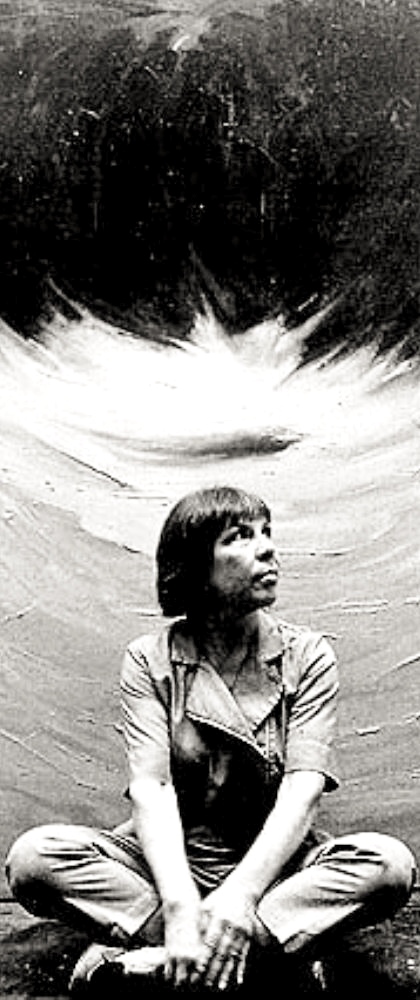Photography of artist Rita LETENDRE (1928)
Photography of Rita Letendre
Credit photograph unknown.
Note!!! – This post is for didactic purposes only!
Rita LETENDRE (1928)
Automatist, colorist, muralist, engraver are all terms that we used to try to define the painter Rita Letendre and her work.
Born in Drummondville in 1928 to a Quebec mother and a Native father of Abénaki origin, she is the oldest of a poor family of seven children. In 1941, she followed her parents to Montreal and took care of her brothers and sisters before working as a waitress and undertaking, at 19, short studies at the École des beaux-arts de Montréal. This rigid and conservative art environment contrasts with the one she discovers following her meeting with Paul-Émile Borduas and his friends, the signatories of the Refus global.
Leaving school and influenced by this avant-garde group with original and modern thinking, she developed her own style, her own way of seeing her works. From the figurative style, she goes to the abstract, realizing that the object represented is not the essential vehicle of emotion.
The exhibition “The material sings” organized by Borduas in 1954 will be significant for her; she will make her known in the community and will give her confidence in her art where her work is noticed by the critic Rodolphe de Repentigny. She will then make numerous stays abroad and it was in Italy that she met the Israeli sculptor Kosso Eloul, who shared her life for 30 years, until his death in the mid-1990s.
Her first solo event took place in 1955 at the L’Échourie gallery. Then, in 1961, the Montreal Museum of Fine Arts presented a selection of his large format works.
New York, Toronto, Vancouver, Los Angeles, Paris, Rome, San Francisco, Winnipeg, Tel Aviv, Quebec and Montreal are just a few places where we will see the works of Rita Letendre in solo or group exhibitions.
She explores several styles and techniques over the years, creating original works, paintings that are distinguished by lines and colors, but also by their size.
Her career is characterized by a great coherence which led her from a structured gestural abstraction from the 1950s-1960s to the hard-edge and geometric abstraction of the late 1960s and 1970s, the period during which she developed her favorite motif: the arrow.
Her first large-scale work is a 24 by 21 foot mural titled Sunforce in 1965 which she produced for the University of California at Long Beach, and her largest, a 60 by 60 foot work entitled Sunrise in 1971 that can be seen on the exterior wall of the Neill-Wycik building at Ryerson University in Toronto.
The whole of Rita Letendre’s work is a love story with light and colors. Her paintings are distinguished by their intensity, and her painting evolves while keeping a dominance of light and energy. The shapes are simple and catch the eye. She masters materials and explores techniques; she works directly on the canvas, without intermediate or preparatory steps.
She went from brush to spatula, to hand, to gouache, to pastel, to airbrush, to casein then from lithography to serigraphy and many other techniques.
During her career, she won numerous prizes and grants, including the Rodolphe-de-Repentigny prize in 1960.
One can admire her works in numerous private and public collections.
Retrospective exhibition of her collection at the Musée du Québec: Rita Letendre in 2003.
See an artwork by Rita Letendre
See more photographs,information, news and bio’s of artists>>
Date:
June 16, 2020
See more artworks and bio of
Artists Gallery